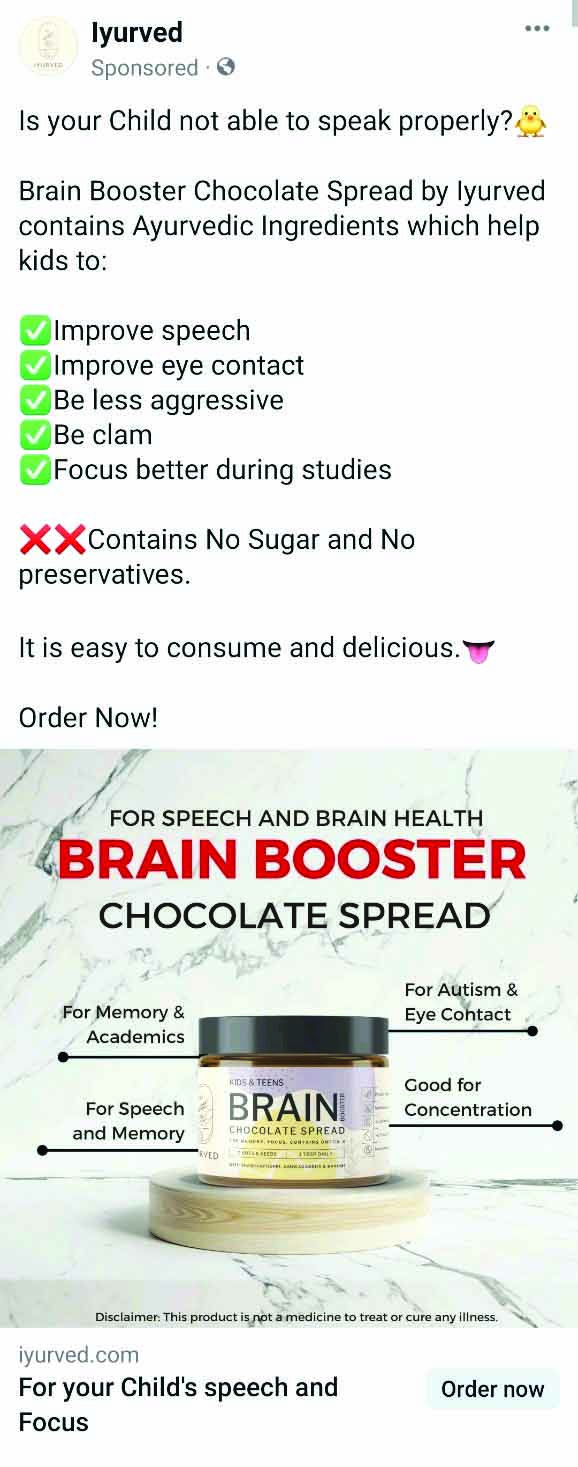No products in the cart.
Protecting children from the insidious influence of advertising
Though their circle of influence and persuasion encompasses all, advertisements have an outsized impact on vulnerable children and teenagers. They significantly influence children’s preferences, behaviour, health and well-being – Aruna Raghuram
 Ads, ads, ads — there’s no way you can escape them. They are everywhere — in newspapers, television, FM radio, Internet, social media apps, billboards, bus/auto backs, and bus stops. Though their circle of influence and persuasion encompasses all, advertisements have an outsize impact on vulnerable children and teenagers. They significantly influence children’s preferences, behaviour, health, and well-being.
Ads, ads, ads — there’s no way you can escape them. They are everywhere — in newspapers, television, FM radio, Internet, social media apps, billboards, bus/auto backs, and bus stops. Though their circle of influence and persuasion encompasses all, advertisements have an outsize impact on vulnerable children and teenagers. They significantly influence children’s preferences, behaviour, health, and well-being.
The American Psychological Association (APA) estimates that children view 40,000 commercials annually, primarily on YouTube and social media. In India, surveys estimate that children spend more than three hours per day online, mostly on social media and gaming apps where they are exposed to an avalanche of ads plugging junk food such as wafers, colas, and chocolates.
According to a 2022 research paper published in Pediatrics titled ‘Advertising and Young People’s Critical Reasoning Abilities: Systematic Review and Meta-analysis’, most advertising targeting children is of processed foods and toys. The study found that constant exposure to ads prompts behavioural changes in children, and sharply influences their preferences because “critical reasoning abilities did not appear to be fully developed during adolescence and not found to be protective against the impact of advertising”. It advised “policymakers to ensure regulations to restrict marketing of unhealthy commodities to protect adolescents as well as younger children”.

Dr. Meghna Singhal
“All children, especially those below 12 years of age, are highly impressionable. They lack cognitive capability to differentiate between entertainment and persuasive intent. Children get carried away by the catchy jingles, cartoon characters and fun and excitement promised by ads,” says Dr. Meghna Singhal, a Bengaluru-based trauma-informed psychotherapist who specializes in childhood and adolescent mental health.
Dr. Singhal specially deplores advertisements of sugary foods and drinks targeting children. “There is scientific evidence that children who watch food advertisements consume more processed food. Ads promoting junk foods and sugary cereals have majorly contributed to childhood obesity in the country. Similarly, children repeatedly exposed to toy advertisements tend to develop biases and prejudices. For instance, Barbie dolls reinforce gender stereotypes while toy guns trigger aggression in young children,” she says.
While teenage children tend to be more aware of advertising tactics to lure customers, because of peer pressure to “look good”, they are also highly influenced by beauty and fashion advertisements glorifying unrealistic body shapes and stereotypes. According to Dr. Singhal, constant exposure to these ads triggers poor body image issues leading to eating disorders and mental health problems among teens, and impulse spending on fashion brands.
The Ahmedabad-based Consumer Education and Research Centre (CERC, estb. 1978), the country’s premier consumer rights and education non-profit organization, has consistently challenged advertising making misleading claims. CERC has filed several complaints against well-known brand ads targeting children and spreading disinformation.

Anusha Iyer
“We have challenged several advertising campaigns. For instance, a Tropicana Essentials Fruit and Veggies ad depicting a child refusing to eat carrots because the vegetable has ‘hair’. Instead, a packaged fruit juice is offered to her, which she relishes. The ‘hair’ is carrot fibre. We complained about this ad to the Advertising Standards Council of India (ASCI), an independent self-regulatory organisation, which upheld our complaint,” says Anusha Iyer, deputy general manager, CERC.
Some other ads that CERC has challenged include a Colgate toothpaste campaign that claimed it ‘gives nutrition’ to teeth (‘paste hi nahi poshan hai ye’) and Complan (high in sugar) which claimed it can ‘help a child grow 2x times’. “Another shocking and disturbing ad claimed that consuming a ‘Brain Booster’ chocolate spread can help children with autism. CERC challenged it and ASCI asked the company to withdraw the ad,” says Iyer.
Similarly, a Himalaya facewash ad claimed that it can get rid of pimples of teens. “How can a topical product get rid of pimples? Parents have a special duty to educate children about not taking ads at face value and fact checking their claims,” adds Iyer.
Singhal concurs that parents have an important role to play in educating children about the “real purpose” of ads. “It’s important to start talking to children about how ads work from young age, and advise them to become active, rather than passive consumers. First, explain to them that ads are not entertainment though many are entertaining, and their real purpose is to make you purchase, either a product or service. Second, tell them that ads tend to exaggerate the features or benefits of the product/service. Give them a clear explanation that advertising’s primary goal is to persuade people to buy products and services, and to generate brand loyalty. Follow this up with discussions about consumerism and the value of money, and how purchasing decisions should be made based on needs and not on ad claims. Parents should have age-appropriate discussions with their children on ads, encouraging them to think critically to curb the negative influence of advertising,” advises Dr. Singhal.
She suggests some ways for parents to educate children about advertising, as well as to limit their exposure to ads:
Teach children not to believe tall claims made in ads on TV, the internet or social media.
Limit online screen time for young children and ensure that they access ad-free online platforms.
During commercial breaks on TV, encourage children to take ‘ad breaks’ to walk around the house, get a drink of water or have a light snack.
If you are co-viewing TV/YouTube with children take the opportunity to discuss ads being telecast highlighting exaggerated claims.
Explain why you are saying ‘no’ when you decline to buy a product for them.
Encourage activities that don’t rely on branded toys/games, such as reading, storytelling and outdoor play.
Initiate discussions with children about the claims ads make and how they manipulate thinking and emotions.
Particularly for teenage children, challenge and question beauty and lifestyle myths promoted by ads. Explain how photoshop/AI are being used to enhance beauty of models/celebs.
Encourage children to follow body positive social media influencers.
Lead by example with healthy consumption habits.
Ask your child’s school to introduce ‘Media Literacy’ workshops to make children aware of the hidden agenda of advertisers.
 Educating kids about advertising: 10 questions to ask
Educating kids about advertising: 10 questions to ask
PW spoke to consumer education experts to suggest 10 questions to pose to children to initiate meaningful discussions about the role and impact of advertising on purchase decisions, health and well-being.
- How do you feel when watching an advertisement? Do you feel excited, anxious to buy the product to ensure acceptance by your peers, or a sense of FOMO (fear of missing out)
- Who is paying for this ad? What is the advertiser’s motivation?
- How real is the lifestyle shown in the ad? Does anything seem deceptive?
- What does the ad say about gender, body shape and cultural diversity?
- Do celebs endorsing a product genuinely recommend it or are they extolling its virtues because they are paid to promote it?
- Does the ad promote the product by giving freebies? For example, do you get a toy if you buy a meal from a fast-food outlet?
- Why aren’t veggies and fruits advertised like burgers, chips and soft drinks?
- How does your browsing information or what you post on social media affect the kinds of ads you see?
- Does the ad ask you to play a segment of a new game or click a link to another page?
- Can you tell the difference between advertising messages that inform and educate as against ads promoting/selling products?
CCPA advertising guidelines to protect children
The Central Consumer Protection Authority (CCPA), established in 2020 by the Union ministry of consumer affairs, has set guidelines for advertisements targeting children “to prevent exploitation and ensure fair practices, prohibiting misleading claims, unrealistic expectations, and endorsements that could harm children’s well-being.” Penalties for companies not adhering to these guidelines range between Rs.1-5 lakh.
CCPA guidelines state that ads targeting children should not:
- Encourage or exhibit dangerous behaviour
- Encourage practices that adversely affect the mental or physical wellbeing of children
- Make children feel that they will be ridiculed or made to feel inferior if they don’t purchase featured product or service
- Use words like ‘just’ or ‘only’ to make the product/service seem less expensive
- Directly urge children to make a purchase or persuade their parents to make one
- Junk food ads are prohibited from being aired on children’s TV channels or during a children’s programme
- Should not feature celebrities (not just actors or cricketers but cartoon characters as well) for products which cannot be purchased by children
- Claim that consumption of a product will enhance intelligence or physical ability
- Convey that the product is better than natural/traditional foods consumed at home
Post Views: 96
Tags: ParentesWorld April 2025






 Educating kids about advertising: 10 questions to ask
Educating kids about advertising: 10 questions to ask








Add comment